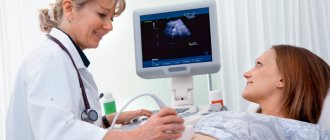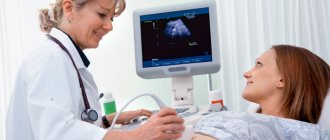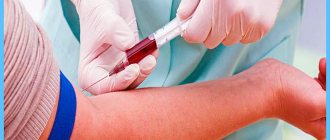Ovulation and timing of fertilization
OVULATION (from Latin ovum - egg) - the release of a mature egg capable of fertilization from the ovarian follicle into the abdominal cavity; stage of the menstrual cycle (ovarian cycle). Ovulation in women of childbearing age occurs periodically (every 21-35 days). The frequency of ovulation is regulated by neurohumoral mechanisms, mainly by gonadotropic hormones of the anterior pituitary gland and ovarian follicular hormone. Ovulation is promoted by the accumulation of follicular fluid and the thinning of the ovarian tissue located above the protruding pole of the follicle. of ovulation, which is constant for every woman, undergoes changes within 3 months after an abortion, within a year after childbirth, and also after 40 years, when the body prepares for the premenopausal period. Ovulation stops with the onset of pregnancy and after the cessation of menstrual function. Establishing the date of ovulation is important when choosing the most effective time for fertilization, artificial insemination and in vitro fertilization.
Signs of ovulation
Subjective signs of ovulation may include short-term pain in the lower abdomen. Objective signs of ovulation are an increase in mucous discharge from the vagina and a decrease in rectal (basal) temperature on the day of ovulation with an increase in it the next day, an increase in the content of progesterone in the blood plasma, etc. Ovulation are caused by dysfunction of the hypothalamic-pituitary-ovarian system and can be caused by inflammation genitalia, dysfunction of the adrenal cortex or thyroid gland, systemic diseases, tumors of the pituitary gland and hypothalamus, stressful situations. The absence of ovulation during childbearing age (anovulation) is manifested by a disturbance in the rhythm of menstruation such as oligomenorrhea (menstruation lasting 1-2 days), amenorrhea, and dysfunctional uterine bleeding. Lack of ovulation (anovulation) is always the cause of a woman’s infertility. Methods for restoring ovulation are determined by the cause that caused anovulation and require a visit to a gynecologist and special treatment.
Basal temperature measurement
Basal temperature is the temperature in the rectum. It is measured immediately after sleep (at least 6 hours) with a special thermometer; the procedure is painless. It is necessary to take measurements every day for several cycles to detect changes indicating ovulation. Basal temperature rises sharply during ovulation and remains unchanged until the end of the cycle. The disadvantage of this method is that other factors, such as viral diseases and inflammatory processes, can affect the thermometer readings.
Ovulation and contraception
Some women experience peak sexual arousal around the days of ovulation . However, the use of a physiological method of contraception from pregnancy, based on sexual abstinence during ovulation , is especially difficult for young spouses, whose frequency of sexual intercourse reaches a fairly high level. In addition, with strong love excitement and nervous stress, additional ovulation can occur (especially with episodic, irregular intercourse) and then not one, but two eggs mature in one menstrual cycle. This should be kept in mind when choosing one or another method of contraception.
When to see a doctor?
In fact, the line between just pain during ovulation and pain that is a good reason to see a doctor is very, very blurry. If only because, as has been said more than once, everything is very individual for everyone, which is why each case requires separate consideration. However, there are a couple of symptoms that should alert a girl.
Firstly, these pains are regular. They always occur at the same time and last quite a long time. Secondly, they are so strong that they interfere with your daily activities. Thirdly, in addition to pain, you experience weakness during ovulation, dizziness, nausea, and these symptoms do not go away for more than a day. That's when you need to make an appointment with a doctor.
To avoid worries, remember two simple rules. First, listen to yourself, observe and try to record the norm in order to distinguish it from disturbing symptoms. Secondly, you need to visit a gynecologist with subsequent smear tests and ultrasound of the genitals and abdominal cavity at least once a year. Then you will know exactly what your personal signs of ovulation are and when to expect it.
Timing of ovulation
It should be noted that different women have a noticeable difference in the timing of ovulation . And even for the same woman, the exact timing of the onset varies from month to month. Some women have extremely irregular cycles. In other cases, cycles may be longer or shorter than the average of 14 days. In rare cases, it happens that in women with a very short cycle, ovulation occurs around the end of the menstrual bleeding period, but in most cases, ovulation occurs quite regularly.
If for one reason or another ovulation does not occur, the endometrial layer in the uterus is thrown out during menstruation. If the fusion of the egg and sperm has occurred, then the cytoplasm of the egg begins to vibrate very strongly, as if the egg is experiencing an orgasm. Sperm penetration is the final stages of egg maturation. All that remains of the sperm is its nucleus, where 23 chromosomes are tightly packed (half the set of a normal cell). The sperm nucleus now quickly approaches the egg nucleus, which also contains 23 chromosomes. The two nuclei slowly touch. Their shells dissolve and their fusion occurs, as a result of which they are divided into pairs and form 46 chromosomes. Of the 23 chromosomes of the sperm, 22 are completely similar to the chromosomes of the egg. They determine all physical characteristics of a person except gender. The remaining pair from the egg always contains an X chromosome, and from the sperm there may be an X or Y chromosome. Thus, if there are 2 XX chromosomes in this set, then a girl will be born, if XY, then a boy.
No pregnancy
If a woman has undergone a full examination and the doctor has not identified any problems other than late ovulation, pregnancy is quite possible. The only problem in this case will be the difficulty in determining favorable days for conception. But, as mentioned above, ultrasound, measuring basal temperature and ovulation test strips will help in this matter.
If the couple has no problems, and the desired conception does not occur, and the cause cannot be established, then doctors can diagnose psychological infertility. In this case, the situation when there is ovulation, but pregnancy does not occur, is a common occurrence. The specialist may prescribe additional examination. Recommendations include active walks, diet, and avoidance of stress. Most often, after a woman leaves a stressful job, the situation changes and pregnancy occurs.
Note that ovulation and signs of pregnancy may vaguely resemble each other; the state of the body during this period is very often similar.
Ovulation, conception and gender of the child
Research conducted at the National Institute of Environmental Health Sciences (North Carolina) has shown that not only the actual conception of a child, but also its gender depends on the time of conception in relation to the time of ovulation .
The chance of conception is highest on the day of ovulation and is estimated at approximately 33%. A high probability is also noted on the day before ovulation - 31%, two days before it - 27%. Five days before ovulation the chance of conception is estimated to be 10%, four days before ovulation is 14% and three days before ovulation is 16%. Six days before ovulation and the day after ovulation, the likelihood of conception during sexual intercourse is very low.
If we consider that the average “life expectancy” of sperm is 2-3 days (in rare cases it reaches 5-7 days), and the female egg remains viable for about 12-24 hours, then the maximum duration of the “dangerous” period is 6- 9 days and the “dangerous” period correspond to the phase of slow increase (6-7 days) and rapid decline (1-2 days) before and after the day of ovulation , respectively. Ovulation , as noted above, divides the menstrual cycle into two phases: the follicle maturation phase, which with an average cycle duration is 10-16 days and the luteal phase (corpus luteum phase), which is stable, independent of the duration of the menstrual cycle and is 12- 16 days. The corpus luteum phase refers to the period of absolute infertility; it begins 1-2 days after ovulation and ends with the onset of a new menstruation.
Test to determine favorable days
Today, every woman can easily find out about the time when mature eggs are released using a test that is sold in every pharmacy. An ovulation test during pregnancy is simply useless; it is necessary when a woman is just planning a pregnancy and she needs to know which days are favorable for conception.
There is a misconception that an ovulation test can indicate pregnancy, but special tests should be used to determine this condition.
Ovulation and pregnancy are related concepts, since without ovulation, conception may simply be impossible. It occurs exclusively during the release of mature eggs, which are most inclined to this. Disturbances in the functioning of the ovaries and lack of ovulation can be the causes of infertility.
How follicles mature: normal process and hormonal stimulation
Under the influence of follicle-stimulating hormone, follicles begin to mature in the ovaries. Follicles are small “watery” sacs that contain immature eggs.
In one menstrual cycle, several follicles usually begin to mature at once. However, by the middle of the cycle, one dominant follicle clearly stands out. In rare cases, several of these bubbles can fully mature. The maturation of follicles is accompanied by a slow increase in the concentration of the main female hormone - estrogen - in a woman’s body.
In some cases, for example, with IVF (in vitro fertilization), there is a need to obtain several mature follicles with eggs. This is necessary in order to increase the chances of successful conception in vitro. Excess eggs are frozen in liquid nitrogen and used for new attempts, without torturing the woman with unpleasant and painful punctures.
An increase in the number of normal follicles can be achieved by hormonal stimulation, which affects ovulation. Those. The woman is given a course of hormones that stimulate the maturation of follicles and eggs. If stimulation was not followed by puncture, i.e. conception occurred in a natural cycle, multiple pregnancies are possible. In this case, twins and even triplets will be born in those families where there have never been such cases.
Stimulation of ovulation is required not only for IVF. This treatment is prescribed to women in whose body the level of hormones is lower than necessary for normal ovulation of even one egg. It is important to carry out hormone therapy only with an experienced doctor, since incorrect calculation of the dose of administered hormones will lead to hyperstimulation, which prevents conception. This condition causes severe side effects - vomiting, headaches, tumor growth, weight gain, etc. Thus, other problems are added to infertility.







